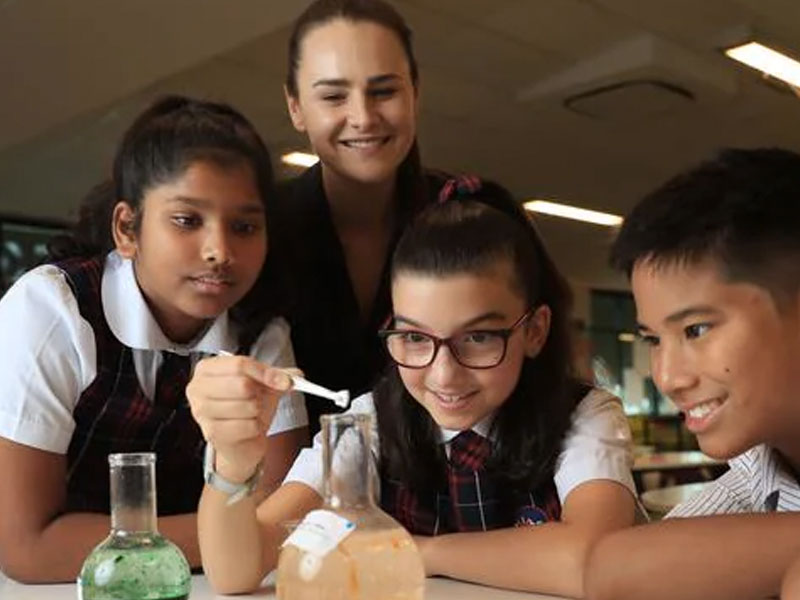
Samantha Devlin with Year 6 St John XXIII Catholic College students Denika Fernandopulle, Mia Lucas and Rafael Nicodemus. Picture: John Feder
Gaming or sport should be used to teach maths to "capture the curiosity" of bored school students, an architect of the new national curriculum has advised.
Mathematician and software expert James Curran, who helped rewrite the new curriculum for digital technologies, called for changes to the way maths is taught to prevent the brain drain of teenagers from science and maths subjects in high school. He said maths could be made more relevant to children interested in online gaming or sport.
"Kids are fundamentally curious but we don’t set up school in a way that harnesses their curiosity so they can learn the things they want to, and the things they have to, all at once," he said. "Putting (maths and IT) in the context of gaming or sport makes a very big difference.
"There are maths teachers who still teach out of textbooks in a way that is devoid of any real-world contexts that students are interested in. Mathematics is often taught in a narrow way."
Dr Curran is chief executive of the Grok Academy, a charity that combines private IT education provider Grok Learning and the Australian Computing Academy from the University of Sydney, where he lectured as an associate professor in computer science for nearly a decade until last year.
Last month the Grok Academy enlisted more than 16,000 school students to stop a simulated cyber-attack on an Australian warship, in a gaming-style Cyber Live event. "If you want to feel like a superhero, cyber security is a great area to do it in," Dr Curran said.
As high school students drop out of advanced maths subjects at record rates, Dr Curran warned that information technology and computing were even less popular with teenagers, exacerbating Australia’s hi-tech skills shortage.
"Traditionally not that many students take IT subjects and numbers have been falling even more precipitously than the maths numbers," he said.
Dr Curran said that in NSW, only 1748 Year 12 students enrolled in software design and development last year – roughly half the 3300 who studied the subject a decade ago. Enrolments have crashed in information processing and technology, from 10,000 in 2001 to just 1939 students in 2021.
In Victoria, barely 400 students studied information, digital media and technology in Year 12 last year, while only 1721 senior students studied digital solutions in Queensland.
Dr Curran blamed the existing seven-year-old syllabus for an exodus of students studying the crucial subject in the senior years of high school.
"Cyber security is one of the new resources that brings the national curriculum up to a good standard," he said. "Students are not taking computing subjects at the senior level and that’s partly because the subject is a bit out of date. Computing is a subject that changes rapidly and needs to be tweaked every few years, not left a decade or more, so I would like to see a continual process of smaller changes and updates."
Dr Curran called on state education departments, as well as private and public schooling systems, to pool their expertise in teaching maths. "It’s almost pre-Industrial Revolution that we haven’t worked out how to share resources to make the job easier for all teachers," he said.
"It’s about changing the system so education departments invest more in centralised resources, curated so it’s easier for teachers to pull out (lessons) that are interesting to individual students."
As schools struggle to convince students to stick with the STEM subjects of science, technology, engineering and maths, 1000 primary schools across Australia have signed up to a new careers counselling program to get young kids interested in hi-tech careers.
The uses online lessons to show children as young as six how emergency services direct triple-0 calls, the process of designing the Olympics logo, and how Netflix mines data to decide which movies to make.
The program’s co-founder, Samantha Devlin, said she wanted to make children’s career choices "less random". "They rule out technology because they don’t know the jobs that exist," she said.
The careers program is being introduced to St John XXIII Catholic College in Stanhope Gardens in Sydney, where principal Peter Webster hopes it will spark interest in STEM subjects.
"Our students will have not just one career but many, so we need to develop a range of skills in communication, collaboration, connectivity and critical thinking," he said. "Often they don’t know what range of opportunities there are in technology."
Eleven-year-old student Mia Lucas said she "had fun" completing a model on UX design – the "user experience" process that design teams use to create products.
"I’ve always been interested in creating a website or an app but didn’t know the first step in doing that," she said.
"I like collecting data, doing measurements, times tables, equations and everything, and my mum and dad are really good at maths and help me a lot."
